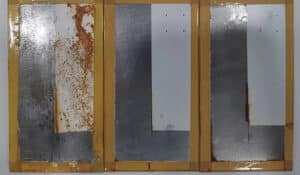
Chromium Coating Quality Testing
Among its various forms, including Electrolizing® TDC and ME-92® Biocompatible chromium coating, Armoloy thin dense chrome coatings are renowned for their impressive wear resistance and minimal dimensional impact. Ensuring the highest quality of these coatings is not a matter of chance; it requires adherence to meticulous testing standards at every stage of the manufacturing process. In this first of two posts, we’ll focus on five testing techniques engineers at the Armoloy Innovation Center utilize to safeguard the integrity and performance of Armoloy TDC coatings. We will explore how these methods are critical in delivering chromium coatings that meet and exceed industry standards.
One: Thickness Measurement
In industrial applications, thickness measurement tests ensure that thin dense chromium coatings adhere to strict specifications that directly influence performance: wear resistance, corrosion resistance, and overall durability and uniformity. Moreover, maintaining the correct thickness is a matter of cost efficiency, as deviations can lead to wastage or necessitate costly rework. Finally, thickness measurements play a role in predictive maintenance strategies, preventing unexpected failures and prolonging the lifespan of the coated component.
Armoloy Innovation Center engineers use several methods for measuring chromium coating thickness:
Microscopic Measurement
Specifically designed for metallographic and quantitative metallography, ASTM B487 measures the microstructural features of electrodeposited coatings, including chromium coating. The test involves the preparation of a cross-section of the coated specimen, which is then polished and examined under a microscope, enabling detailed observation of TDC’s microstructure. ASTM B487 provides guidelines for quantitative analysis of the coating, including measuring the thickness, assessing the uniformity of the deposit, and identifying any discontinuities or defects such as pits, inclusions, or voids. The standard is widely used in quality control and research applications, including automotive, aerospace, electronics, and general manufacturing, where thin dense chromium coatings are valued for corrosion resistance, wear resistance, and aesthetic purposes.
X-ray Fluorescence (XRF)
XRF is another non-destructive testing method — it does not damage or alter the coating or substrate during measurement. It is useful for quality control and inspection in production environments where maintaining the part’s integrity is crucial.
Magnetic Induction Thickness
The magnetic induction thickness test (ASTM D7091) is a non-destructive testing method used to measure the thickness of non-magnetic coatings on magnetic substrates. This method is particularly relevant for chromium coatings, which are commonly applied to ferrous (magnetic) materials. The test works on the principle of magnetic induction. The instrument generates a magnetic field, and the response from the substrate (through the non-magnetic coating) is measured. The thickness of the coating affects this magnetic response, allowing the instrument to calculate the coating thickness. Compliance with ASTM D7091 ensures standardized, repeatable, and reliable coating thickness measurement, which is essential for quality control in manufacturing and maintenance processes.
Ultrasonic Thickness Gauges
Ultrasonic thickness gauges, where sound waves measure coating thickness, are highly versatile and used in applications like corrosion monitoring, quality control in manufacturing, and material research. This testing method is particularly valuable when access is limited to only one side of the measured material. In addition to metal, ultrasonic thickness gauges can be used for plastics, ceramics, composites, and glass, among others, though they require good surface contact and calibration.
Two: Adhesion Testing
Adhesion testing ensures coating integrity by verifying that it adheres properly to the substrate, a critical factor for the TDC performance under various service conditions, including exposure to mechanical stress and environmental factors. These tests are integral to quality control and provide insights into the long-term behavior of the TDC, predicting its longevity and resilience.
ASTM B571, an essential standard practice for assessing the adhesion of chromium coatings to various substrates, outlines several different methods for qualitative assessment of adhesion. Bend Test
The Bend Test is a method used to assess the adhesion and flexibility of TDC coatings under deformation, bending, or flexing stresses. After bending, the chromium coating is inspected for cracking, detachment, or other failures. The degree to which the coating withstands bending without damage indicates its adhesion quality and flexibility.
Scribe-and-Grid Test
This test involves scribing through the coating to the substrate in a grid pattern and then applying tape over the scribed area. Upon removing the tape, the amount of coating that peels off indicates adhesion quality.
Heat-Quench Test
For coatings that might be subject to heat, this test involves heating the coated part and quenching it in water. Poor adhesion is indicated by the coating blistering or peeling off. Poor adhesion is indicated by the coating blistering or peeling off.
Impact Test
In the impact test, a coated panel is subjected to a falling weight or pendulum to test the adhesion under impact conditions. The deformation or removal of the coating at the impact site indicates the adhesion quality.
Three: Hardness Testing
A significant aspect of the value of chromium coatings is their hardness. Hardness testing in the context of coatings like chromium involves measuring how resistant the surface is to deformation or penetration. Common methods include:
Microhardness Test
TDC coatings are known for their high hardness levels. The microhardness test quantitatively measures this property, providing valuable data on the coating’s quality and effectiveness. Typically, Vickers or Knoop hardness tests are employed. These tests involve pressing a diamond indenter into the coating surface under a specific load and then measuring the size of the indentation. Since TDC coatings are thin, the test loads are generally light to prevent penetration through the coating into the substrate, ensuring that the hardness measurement reflects the properties of the chromium layer itself, not the underlying material. The hardness value obtained indicates the coating’s wear resistance. Higher hardness generally correlates with better wear resistance, which is desirable in many industrial and engineering applications where chromium coatings are subjected to significant mechanical stress or wear.
Electrolizing® TDC imbues the metal surface with an impressive hardness level, reaching up to 72 on the Rockwell C scale. Despite this remarkable hardness, Electrolizing® coatings maintain a notable level of ductility. The compact nature of the coating ensures a smoother surface, characterized by fewer fissures, impurities, gaps, and other surface imperfections, especially when contrasted with traditional chrome plating methods. This fusion of exceptional hardness and compactness leads to diminished wear and tear alongside a lower coefficient of friction.
Nanoindentation
In industries where the mechanical integrity of materials at the microscopic level is crucial — from aerospace and semiconductors to biomedical devices and dental surgical tools — nanoindentation is used for quality control and assurance. A more advanced testing technique, Nanoindentation allows for extremely precise measurements, suitable for very thin coatings.
Four: Corrosion Testing
Corrosion is a massive issue in industrial applications — even the strongest metals, such as stainless steel, experience degradation over time, and can ultimately lead to catastrophic metal failure. Corrosion resistance testing is critical for evaluating the longevity and durability of chromium coatings, including specialized forms like thin dense chrome.
Salt Spray Test
In this test (ASTM B117), the coated samples are exposed to a fine mist of saltwater solution, typically sodium chloride, to simulate a corrosive, marine-like environment. After the test (duration of exposure is usually 50 hours), the samples are examined for signs of corrosion, such as rusting, blistering, or loss of adhesion. The extent and type of corrosion, rusting, blistering, or loss of adhesion — all causes of metal failure — are used to evaluate the coating’s resistance.

salt spray test anti corrosion paint
Cyclic Corrosion Testing
This is an accelerated test used to predict corrosion life under real-world conditions. Many cyclic corrosion tests that vary temperature, humidity, and chemical exposure over time have been developed to understand how a component or assembly will perform.
One common cyclic corrosion test is SAE J2334. Also known as the “Cosmetic Corrosion Lab Test,” SAE J2334 is a standard used to evaluate the cosmetic corrosion resistance of automotive materials. This test method simulates the corrosive effects of road salts, acid rain, and other environmental factors on automotive parts. It’s especially relevant for materials and coatings used in the automotive industry, including body panels, underbody components, and other parts exposed to harsh environmental conditions.
Five: Wear Resistance Testing
Wear resistance testing is essential in industrial applications where the surface is subject to mechanical wear, including physical abrasion, impact, and erosion.
Pin-on-Disk Test
In this test, (ASTM G99) a pin or ball made of a standard material is pressed against the coated disk, which is then rotated. The wear rate is determined by measuring the loss of material over time.
Taber Abrasion Test
This method uses a pair of abrasive wheels that rub against the coating under a specified load. The amount of wear is measured after a set number of cycles. ASTM D4060 is a standardized test method for determining the resistance of organic coatings to abrasion produced by the Taber Abraser on coatings applied to a plane, rigid surface, such as a metal panel.
Four-Ball Test
Also known as the Four-ball Wear or the Four-ball EP (extreme pressure), this test is used to measure the lubrication properties of a lubricant, particularly its ability to withstand EP conditions. In machinery or automotive parts where chromium-coated components are used, the lubricating grease’s effectiveness, as assessed by the Four-Ball Test (ASTM D2596) is crucial. The test ensures that the grease can protect these components under high-pressure conditions, which is vital for the longevity of both the coating and the underlying material.
Dry Sand/Rubber Wheel Test
This test involves abrasive particles (like sand) being forced against the coating under pressure, simulating abrasive wear conditions. The apparatus consists of a rubber wheel, against which the test sample is pressed. As the wheel rotates, the abrasive particles are forced against the sample, simulating abrasive or erosive wear. The test (ATSM G65) can be conducted under varying loads and for different durations to simulate various conditions. The sample’s wear resistance is typically measured by the loss of mass or by measuring the depth or volume of material removed due to abrasion.
Stay tuned for our second in this series of posts, exploring the various testing techniques used to ensure the quality of an Armoloy chromium coating, including microstructural analysis, porosity testing, chemical composition, and roughness measurement.
Quality Control at Every Stage of Production
In partnership with the Armoloy Corporation’s Innovation Center, our Processes Engineering Facilities aim to identify and document process parameters to maintain tight quality controls and mitigate variabilities at every stage of the manufacturing process. From research and development to long-term performance assessments, Electrolizing is here to meet the demands of your industrial and commercial applications.